How to identify YouTube Partner Program scams
Phishing/ScamAlso Known As: "YouTube Partner Program Monetization Update" phishing scam
Get free scan and check if your device is infected.
Remove it nowTo use full-featured product, you have to purchase a license for Combo Cleaner. Seven days free trial available. Combo Cleaner is owned and operated by RCS LT, the parent company of PCRisk.com.
What kind of scam is "YouTube Partner Program Monetization Update"?
"YouTube Partner Program Monetization Update" is a scam that targets YouTube account log-in credentials. This phishing campaign has been active since January of 2024.
It is typically initially through spam emails directing users to an AI-generated video of the YouTube CEO announcing changes in channel monetization. The link in the video's description leads victims to a phishing website that records entered credentials.
It must be emphasized that this scam is not associated with the actual YouTube online video-sharing platform or its parent company – Google LLC.
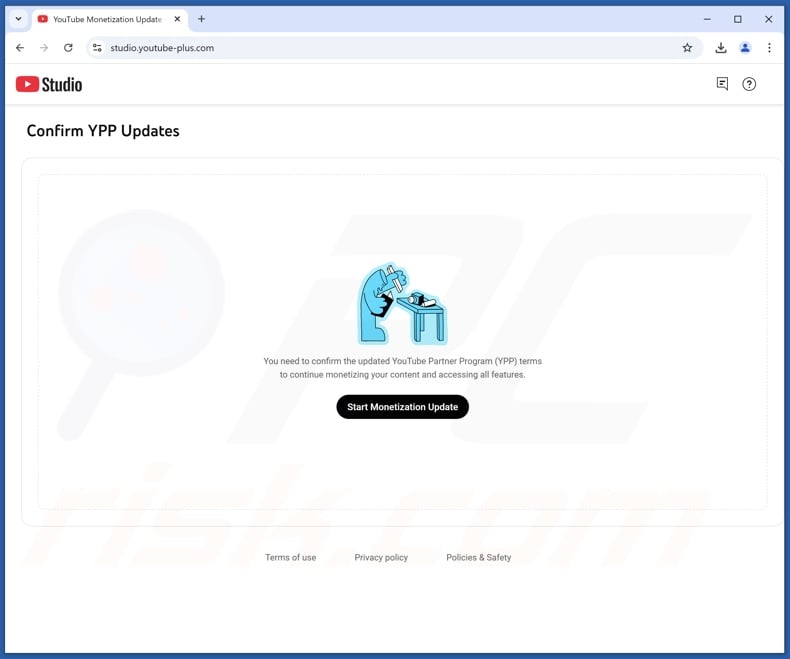
"YouTube Partner Program Monetization Update" scam overview
This scam begins with spam emails sent to YouTube account owners. These fraudulent alerts notify recipients of updates to YouTube's monetization policies and direct them to a video announcing these changes. The scam can craft a sense of urgency by warning that YouTube accounts may be restricted for seven days if no agreement is provided for the policy updates.
The linked video is private and was produced using AI (Artificial Intelligence). It depicts the YouTube CEO – Neal Mohan – announcing the changes to account monetization. The description of this fraudulently manufactured video includes a link to a webpage where creators can confirm their agreement to the policy changes.
The website reiterates this – "You need to confirm the updated Youtube Partner Program (YPP) terms to continue monetizing your content and accessing all features." and when the – "Start Monetization Update" button is pressed, a new page is opened. It requests to provide log-in credentials for the YouTube account.
Once the information is entered, the phishing website records the data and sends it to scammers. After the "Sign In" button is clicked, another page is opened, which states – "Your channel is now pending. Open the document in the video description for all the necessary information".
Stolen YouTube channels can be variously abused. It was noted that some of the accounts hijacked through this campaign were used to live-stream cryptocurrency scams.
To summarize, victims of scams like "YouTube Partner Program Monetization Update" can experience severe privacy issues and financial losses.
If you have already entered your log-in credentials into a phishing website or file – immediately change the passwords of all potentially exposed accounts and inform their official support.
| Name | "YouTube Partner Program Monetization Update" phishing scam |
| Threat Type | Phishing, Scam, Social Engineering, Fraud |
| Fake Claim | YouTube creators must agree to changes to monetization policies. |
| Disguise | YouTube |
| Related Domains | studio.youtube-plus[.]com |
| Detection Names | ESTsecurity (Malicious), Fortinet (Phishing), Full List Of Detections (VirusTotal) |
| Serving IP Address | 104.21.41.161 |
| Distribution methods | Spam emails, compromised websites, rogue online pop-up ads, potentially unwanted applications. |
| Damage | Loss of sensitive private information, monetary loss, identity theft, possible malware infections. |
| Malware Removal (Windows) |
To eliminate possible malware infections, scan your computer with legitimate antivirus software. Our security researchers recommend using Combo Cleaner. Download Combo CleanerTo use full-featured product, you have to purchase a license for Combo Cleaner. 7 days free trial available. Combo Cleaner is owned and operated by RCS LT, the parent company of PCRisk.com. |
Online scams in general
The Internet is rife with deceptive and malicious content. Scams can differ significantly in appearance and modus operandi. In basic terms, the goal of a scam is to trick victims into performing specific actions, which can range from disclosing sensitive data (like passwords) to sending money to scammers.
While online scams are often poorly put together and riddled with mistakes, they can be competently made and even convincingly disguised as content associated with legitimate entities (e.g., companies, organizations, institutions, authorities, etc.).
Due to how prevalent scams are on the Web and how well-crafted they can be – we strongly recommend exercising caution when browsing and interacting with online content.
How did I open a scam website?
The "YouTube Partner Program Monetization Update" scam has been promoted through spam emails disguised as messages from YouTube.
Various techniques are used in scam promotion, and all kinds of spam are widely used (e.g., emails, PMs/DMs, social media/ forum posts, SMSes, robocalls/ cold calls, browser notifications, etc.).
Other prevalent methods include malvertising (intrusive ads), websites that use rogue advertising networks (redirects), typosquatting (misspelled URLs), and adware (ads or redirects).
How to avoid visiting scam websites?
Caution is essential to online safety. Therefore, be wary of messages, advertisements, and sites making dubious warnings or unbelievable promises. Do not open attachments or links present in suspect/irrelevant emails or other messages.
Do not use websites offering pirated content or other questionable services (e.g., illegal streaming/downloading, Torrenting, etc.), as these webpages are usually monetized via rogue advertising networks.
Pay attention to URLs and enter them cautiously. Do not permit suspicious sites to deliver browser notifications; ignore or block their notification requests.
Download only from official/verified sources and be vigilant when installing (e.g., study terms and options, use "Custom/Advanced" settings, and opt out of additional apps, extensions, etc.) – to avoid bundled/harmful software (like adware) from infiltrating the system.
If your computer is already infected, we recommend running a scan with Combo Cleaner Antivirus for Windows to automatically eliminate all threats.
Second page of the scam (phishing site targeting YouTube log-in credentials):
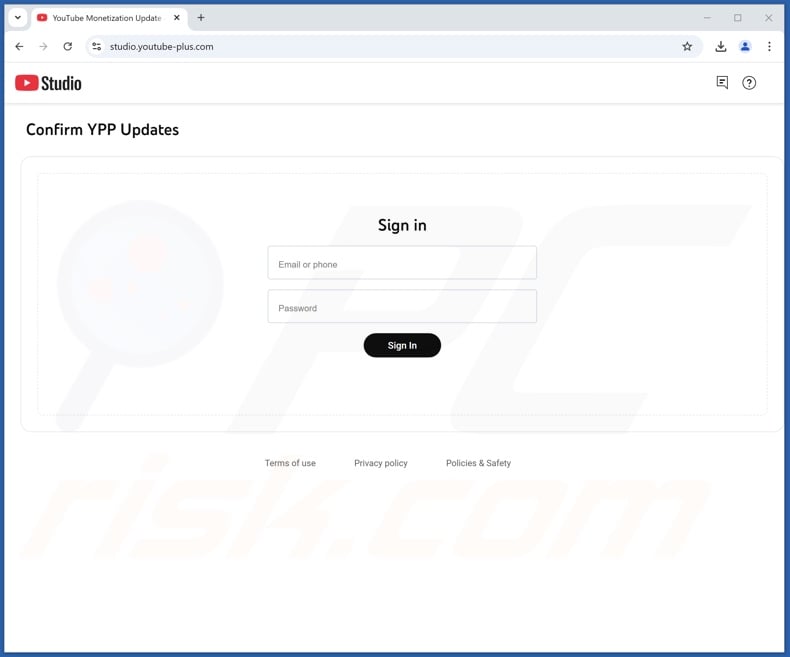
Third page of the scam (claiming YouTube channel is pending):
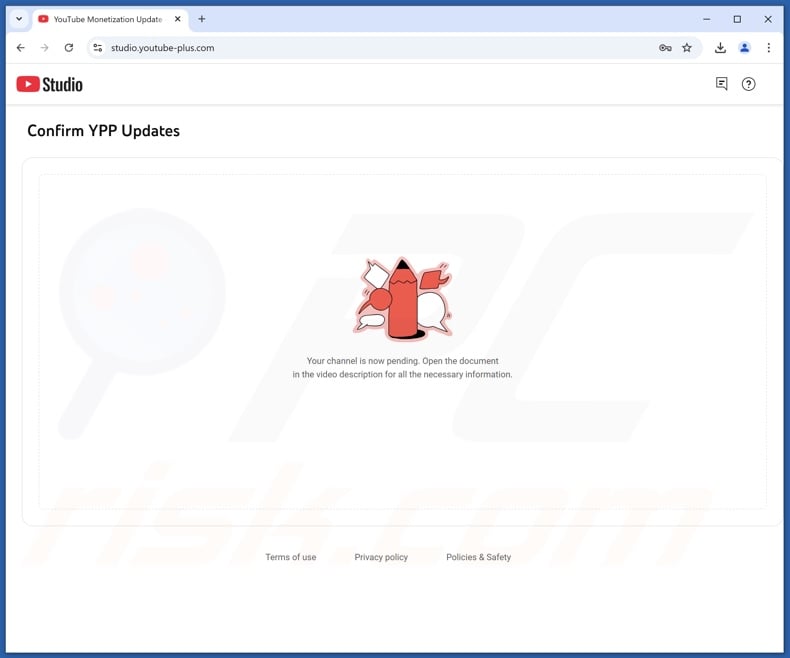
Appearance of the "YouTube Partner Program Monetization Update" scam (GIF):
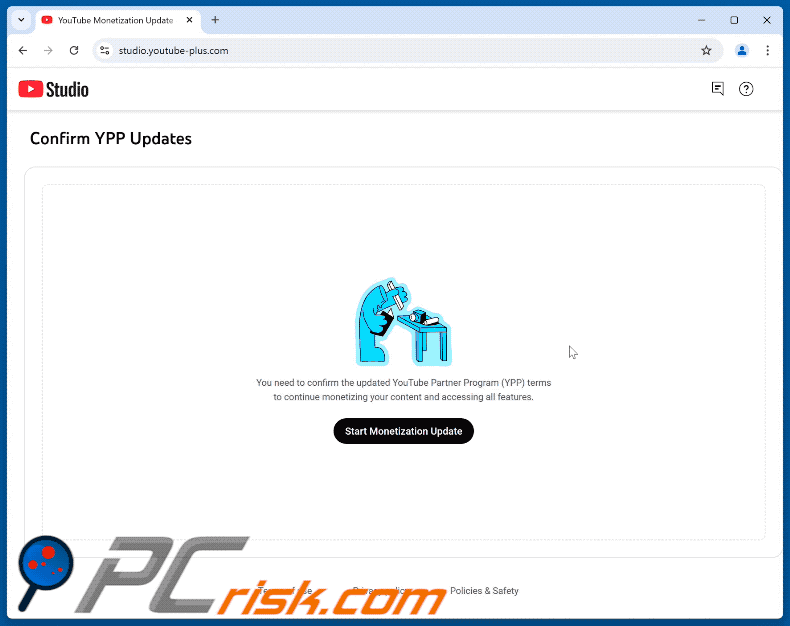
Instant automatic malware removal:
Manual threat removal might be a lengthy and complicated process that requires advanced IT skills. Combo Cleaner is a professional automatic malware removal tool that is recommended to get rid of malware. Download it by clicking the button below:
DOWNLOAD Combo CleanerBy downloading any software listed on this website you agree to our Privacy Policy and Terms of Use. To use full-featured product, you have to purchase a license for Combo Cleaner. 7 days free trial available. Combo Cleaner is owned and operated by RCS LT, the parent company of PCRisk.com.
Quick menu:
- What is "YouTube Partner Program Monetization Update" phishing scam?
- How to identify a pop-up scam?
- How do pop-up scams work?
- How to remove fake pop-ups?
- How to prevent fake pop-ups?
- What to do if you fell for a pop-up scam?
How to identify a pop-up scam?
Pop-up windows with various fake messages are a common type of lures cybercriminals use. They collect sensitive personal data, trick Internet users into calling fake tech support numbers, subscribe to useless online services, invest in shady cryptocurrency schemes, etc.
While in the majority of cases these pop-ups don't infect users' devices with malware, they can cause direct monetary loss or could result in identity theft.
Cybercriminals strive to create their rogue pop-up windows to look trustworthy, however, scams typically have the following characteristics:
- Spelling mistakes and non-professional images - Closely inspect the information displayed in a pop-up. Spelling mistakes and unprofessional images could be a sign of a scam.
- Sense of urgency - Countdown timer with a couple of minutes on it, asking you to enter your personal information or subscribe to some online service.
- Statements that you won something - If you haven't participated in a lottery, online competition, etc., and you see a pop-up window stating that you won.
- Computer or mobile device scan - A pop-up window that scans your device and informs of detected issues - is undoubtedly a scam; webpages cannot perform such actions.
- Exclusivity - Pop-up windows stating that only you are given secret access to a financial scheme that can quickly make you rich.
Example of a pop-up scam:
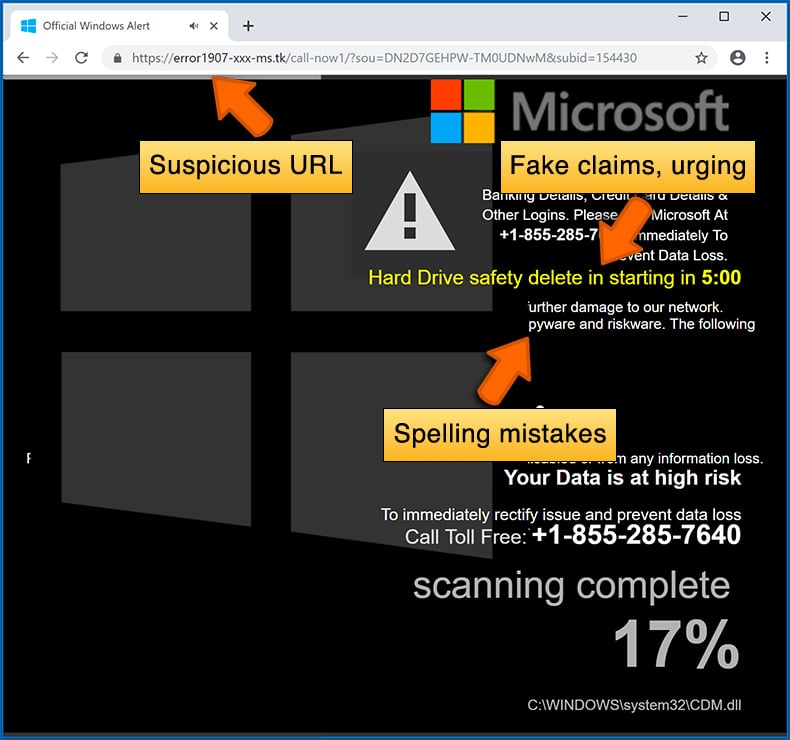
How do pop-up scams work?
Cybercriminals and deceptive marketers usually use various advertising networks, search engine poisoning techniques, and shady websites to generate traffic to their pop-ups. Users land on their online lures after clicking on fake download buttons, using a torrent website, or simply clicking on an Internet search engine result.
Based on users' location and device information, they are presented with a scam pop-up. Lures presented in such pop-ups range from get-rich-quick schemes to fake virus scans.
How to remove fake pop-ups?
In most cases, pop-up scams do not infect users' devices with malware. If you encountered a scam pop-up, simply closing it should be enough. In some cases scam, pop-ups may be hard to close; in such cases - close your Internet browser and restart it.
In extremely rare cases, you might need to reset your Internet browser. For this, use our instructions explaining how to reset Internet browser settings.
How to prevent fake pop-ups?
To prevent seeing pop-up scams, you should visit only reputable websites. Torrent, Crack, free online movie streaming, YouTube video download, and other websites of similar reputation commonly redirect Internet users to pop-up scams.
To minimize the risk of encountering pop-up scams, you should keep your Internet browsers up-to-date and use reputable anti-malware application. For this purpose, we recommend Combo Cleaner Antivirus for Windows.
What to do if you fell for a pop-up scam?
This depends on the type of scam that you fell for. Most commonly, pop-up scams try to trick users into sending money, giving away personal information, or giving access to one's device.
- If you sent money to scammers: You should contact your financial institution and explain that you were scammed. If informed promptly, there's a chance to get your money back.
- If you gave away your personal information: You should change your passwords and enable two-factor authentication in all online services that you use. Visit Federal Trade Commission to report identity theft and get personalized recovery steps.
- If you let scammers connect to your device: You should scan your computer with reputable anti-malware (we recommend Combo Cleaner Antivirus for Windows) - cyber criminals could have planted trojans, keyloggers, and other malware, don't use your computer until removing possible threats.
- Help other Internet users: report Internet scams to Federal Trade Commission.
Frequently Asked Questions (FAQ)
What is an online scam?
Online scams are a type of deceptive content aiming to trick users into performing certain actions. For example, victims can be deceived into disclosing private data, sending money to scammers, purchasing products, subscribing to services, downloading/installing software, calling fake support lines, and so on.
What is the purpose of online scams?
The purpose of online scams is to generate revenue at victims' expense. Cyber criminals predominantly profit by obtaining funds through deception, endorsing content (e.g., websites, software, products, services, etc.), abusing/selling vulnerable information, and spreading malware.
I have provided my personal information when tricked by an online scam, what should I do?
If you have provided your log-in credentials – change the passwords of all possibly exposed accounts and inform their official support without delay. However, if you have disclosed other private information (e.g., ID card details, passport scans/photos, credit/debit card numbers, etc.) – immediately contact relevant authorities.
Why do I encounter online scams?
"YouTube Partner Program Monetization Update" scam has been promoted through spam emails. Generally, online scams are endorsed via different types of spam (e.g., PMs/DMs, social media posts, SMSes, browser notifications, etc.), malvertising (intrusive adverts), websites using rogue advertising networks, typosquatting (misspelled URLs), and adware.
Will Combo Cleaner protect me from online scams?
Combo Cleaner can scan visited websites and detect rogue, deceptive/scam, and malicious pages. Additionally, it can restrict all further access to such sites.
Share:

Tomas Meskauskas
Expert security researcher, professional malware analyst
I am passionate about computer security and technology. I have an experience of over 10 years working in various companies related to computer technical issue solving and Internet security. I have been working as an author and editor for pcrisk.com since 2010. Follow me on Twitter and LinkedIn to stay informed about the latest online security threats.
PCrisk security portal is brought by a company RCS LT.
Joined forces of security researchers help educate computer users about the latest online security threats. More information about the company RCS LT.
Our malware removal guides are free. However, if you want to support us you can send us a donation.
DonatePCrisk security portal is brought by a company RCS LT.
Joined forces of security researchers help educate computer users about the latest online security threats. More information about the company RCS LT.
Our malware removal guides are free. However, if you want to support us you can send us a donation.
Donate
▼ Show Discussion